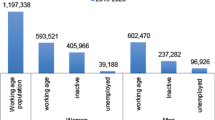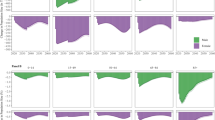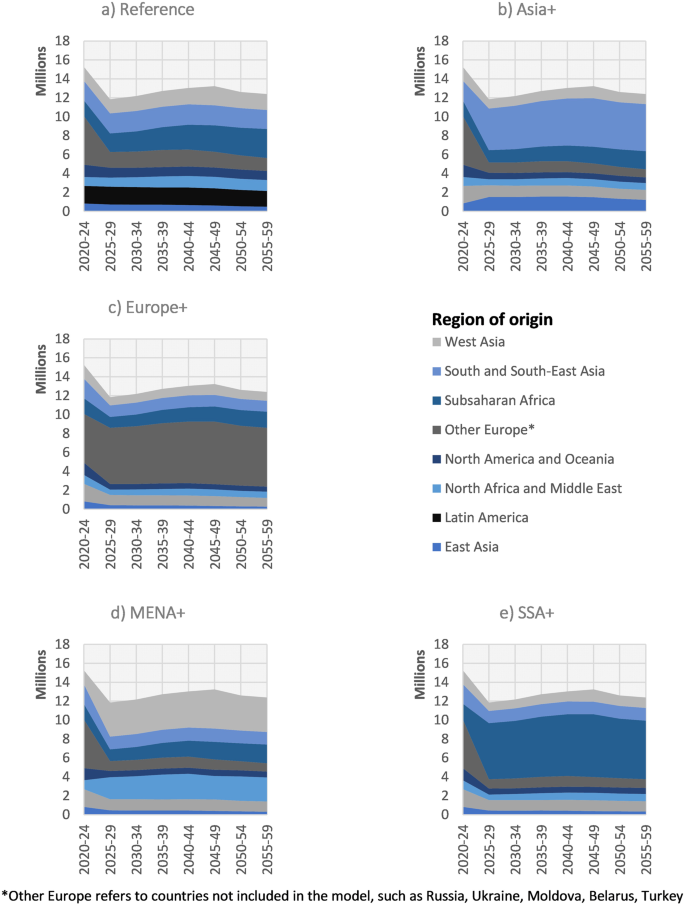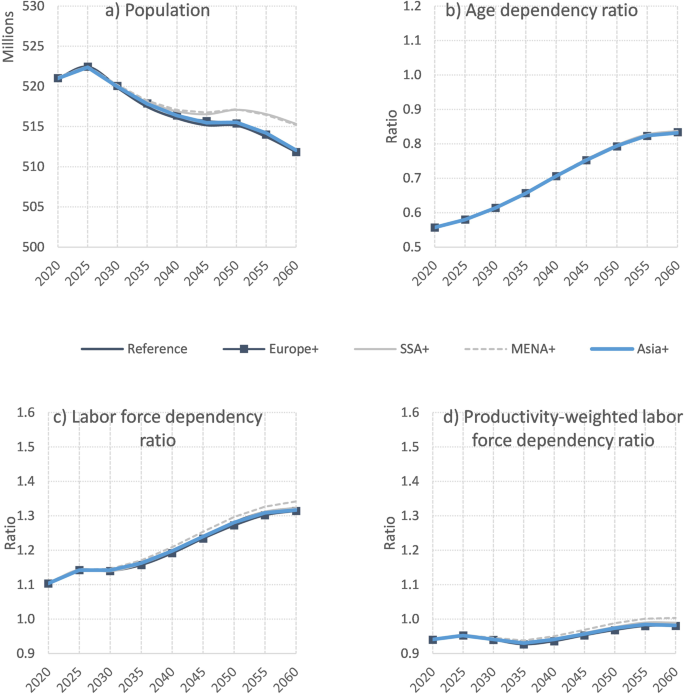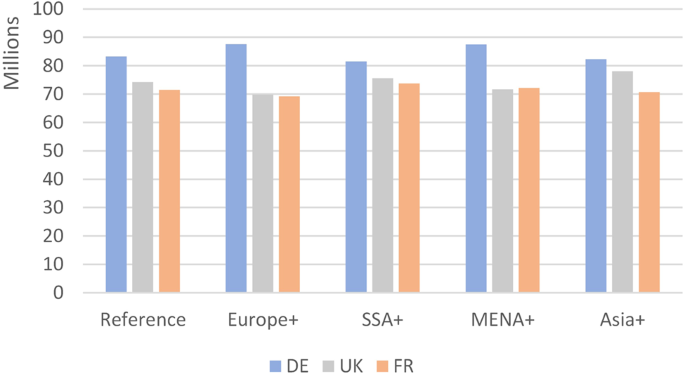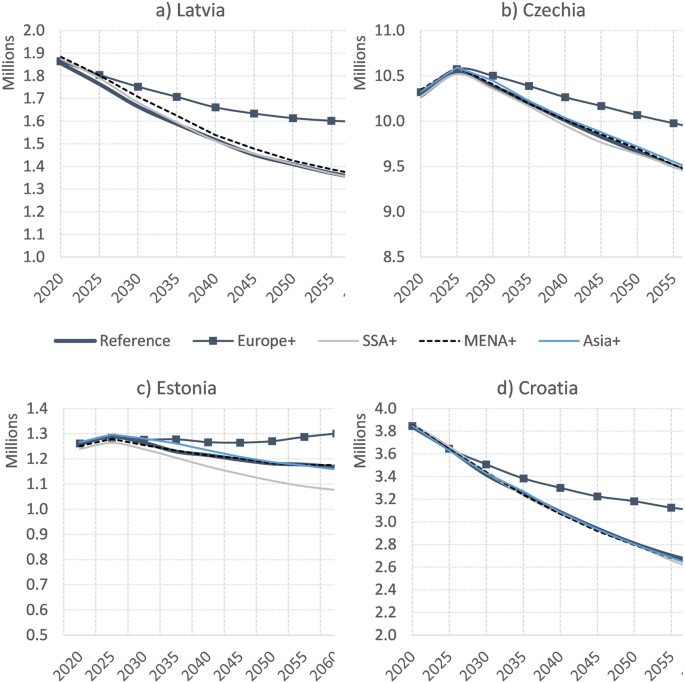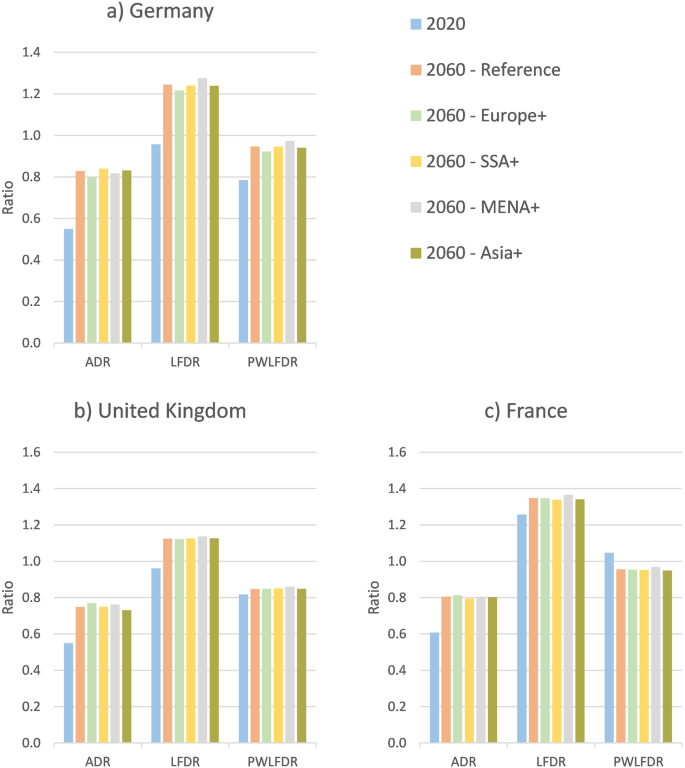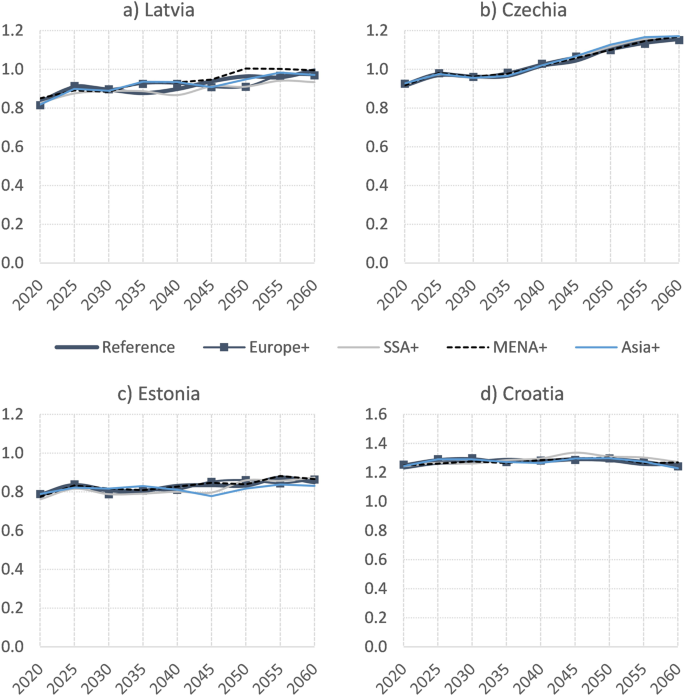Abstract
Immigration has become a key demographic component in developed European nations. At the same time, many countries have seen an increase in immigration from non-European origins and more diversified migrant flows. In most population projections, however, immigrants are considered an almost homogenous population. This study utilizes a population microsimulation projection model (QuantMig-Mic) for 31 European countries that includes place of birth as a source of heterogeneity for components that could impact population size, age structures, and economic dependency ratios. We simulated different scenarios from 2020 to 2060 in which the birth regions of future immigrant flows were changed drastically compared to recent trends. Our results showed that major shifts in the origin of immigration flows toward Europe would impact the spatial distribution of the population in the continent and therefore—at the local level—the population size of some countries. We found that the age structure would be only marginally affected and that shifts in the composition of immigration flows would not significantly alter the increasing age dependency ratio. Moreover, even in the countries most impacted in terms of population size, no scenario led to notable changes in the total labor force participation rate or in the educational structure of the labor force.
Similar content being viewed by others
Introduction
Europe has become a major epicenter of international migration. For a large part of the 20th century, the number of people leaving Europe was higher than the number of people coming in. However, during the 21st century especially, the continent has emerged as a major destination for international migration (de Haas et al., 2019). Many of the immigrants coming to Europe do so with the intention of settling in destination countries; this is in sharp contrast to the predominantly temporary labor migration between South Asia and the Gulf oil-rich countries, which is another large global migration channel (Valenta, 2017). Immigration has become a key demographic component in developed European nations with low fertility; its importance for population change is expected to increase as natural population growth slows down or even turns negative in some countries (Coleman and Rowthorn, 2011). International migration has thus attracted increasing public and political attention in Europe during the past decades.
In this context, several studies have measured the demographic impact of international migration in low-fertility countries (Billari and Dalla-Zuanna, 2011; Newsham and Rowe, 2021). A common approach is to build “what if” scenarios using a population projection model that aims to calculate the impact of different immigration levels in a destination country based on selected demographic indicators, such as population size, working-age population, or the age dependency ratio (Cangiano, 2019; Marois et al., 2020; Potančoková et al., 2021). What we have learned from these demometric papers is that higher immigration levels could significantly impact the population size at the destination level and could also, within realistic parameters, prevent population decline or accelerate population growth. To sustainably modify the age structure of a population, however, and thereby significantly and permanently impacting population aging, immigration levels would have to be constantly growing and quickly reach completely impracticable numbers (Coleman, 2008). One of the most prominent examples of such simulations is a United Nations study that concluded that the whole world population would need to move to South Korea in order to prevent population aging there (UN, 2001; Coleman, 2002). Other projections since then have reached a consensus on these findings from a strictly age-related point of view (Craveiro et al., 2019).
Most exercises usually assess “aging” by categorizing the population according to age groups and looking at the evolution of ratios, such as the “age dependency ratio” (ADR), which is constituted by the population aged 65+ and those aged 0–14, divided by the so-called “working-age population” aged 15–64. This indicator, however, relies on the false hypothesis that past a certain age, all the population is “dependent” and requires state welfare, while all the working-age population is actually working and contributing to social welfare. With the increasing labor force participation rates of the elderly and women (Loichinger, 2015), this indicator might seem to be incomplete, as it does not account for other social changes that can actually shape the real “dependency” ratio (Spijker and MacInnes, 2013). In addition, as not all workers are equally productive, taking into account changes in the productivity of workers through the expansion of educational attainment has also provided a very different picture. Indeed, when more sophisticated dependency ratios are examined, such as the labor force dependency ratio (LFDR) or the productivity-weighted labor force dependency ratio (PWLFDR), population aging looks much less daunting, as it increases much less than the traditional age dependency ratio (Marois et al., 2020).
Assessing the impact of international migration on those more complex dependency ratios is challenging, as it necessitates the use of multidimensional population projection models which include immigrant-related variables (such as immigration status, duration of stay, age at immigration) and the interactions of these with other dimensions such as labor force participation, education, and fertility. Simulations from the Center of Expertise on Population and Migration (CEPAM) provide such simulations which take into account the fact that international immigrants from outside the EU have different behaviors than the native-born in terms of labor force participation and educational attainment (Marois et al., 2020). CEPAM simulations have shown that high but realistic levels of immigration could have a significant positive impact on the labor force and the productivity-weighted labor force dependency ratio where immigrants are well-educated and well-integrated into the labor force, but poorly educated immigrants with low labor force participation could negatively impact the situation (Marois et al., 2020). These simulations thus highlighted that in terms of the sociodemographic impact of international immigration, the labor force integration of migrants matters at least as much as migration volumes.
In all past simulations, however, immigrants have been considered an almost homogenous population, irrespective of the differences they have based on their place of origin. In the 21st century, the origins of immigrants toward southern and western Europe have become more globalized and more diverse (Abel and Cohen, 2019), with successive migration waves often bringing immigrants from previously little-represented countries; this has resulted in the diversification of migrant stock in the populations of European countries. Although some population projections make a distinction between intra-EU migration and migration between EU countries and the rest of the word (Bijak et al., 2007; Potančoková et al., 2021), immigrants from outside the EU are still treated as a homogenous group. Such diversity should not, however, be disregarded because the place of birth is highly correlated with several socioeconomic behaviors, notably labor outcomes (Adsera and Chiswick, 2007), education (Ichou et al., 2017), and fertility (Wilson, 2020). Nevertheless, the question remains as to whether these behaviors differ enough to make a difference to aggregated demographic outcomes. Hence, given the complexity of the modeling needed, might it be valuable to consider details of the place of birth as a source of heterogeneity in population projections for Europe?
For this study, we built a specific microsimulation model (QuantMig-Mic) which includes place of birth as a source of heterogeneity for the various components that could impact population size and the different demographic and economic dependency ratios. Our aim was to measure what would be the impact of major changes in terms of immigrants’ regions of origin on future demographic trends and dependency ratios in European countries up to 2060. Future migration is highly uncertain, and it is impossible to forecast where future migrants might come from. Furthermore, we can expect the diversification of immigration to continue into the future as new and unexpected events due to anthropogenic disasters or climate and environmental change bring immigrants into Europe from origins that have been under-represented until now. Such events are impossible to foresee until they are underway, and simulations offer a feasible tool for exploring the long-term impacts of a changed composition of immigrants in Europe. In this work, we simulated scenarios of drastically changed future origins of immigrants compared to recent trends. In these scenarios, migration is dominated by a specific region of origin. Such simulations are highly relevant in terms of informing the policy implications of potential future shifts in migration toward Europe. In this paper, we compare the resulting outcomes at the country level in terms of population size, age dependency ratio, labor force dependency ratio, and productivity-weighted labor force dependency ratio.
To our knowledge, this is the first study that explicitly includes place of birth as a component of projections with the aim of foreshadowing future population trends. Given its multidimensional properties, the study can be used to assess the impact of different future migration scenarios on various facets of society. In this context, the scenarios presented in this paper are a first attempt to test the sensitivity of this dimension (place of birth) on different sociodemographic outcomes.
Including the place of birth as a source of heterogeneity in a population projection
QuantMig-Mic is a continuous and time-based microsimulation built on the framework of CEPAM-Mic, which has been described exhaustively in other papers (Marois et al., 2019a, 2019b, 2020; Potančoková and Marois, 2020). The model allows for the projection of the population of the 27 countries of the European Union plus the United Kingdom (UK), Norway, Switzerland, and IcelandFootnote 1 under several socioeconomic dimensions together with their interactions, including place of birth, educational attainment, labor force participation, duration of stay, and the age of arrival of immigrants. The place of birth contains 39 categories, either the 31 countries included in the model plus 8 wider regionsFootnote 2 for international migrants as defined by the information provided in the main survey used for modeling events (EU-Labor Force Surveys).
A description of the model and its parameters can be found in Marois et al. (2023). Compared to CEPAM-Mic, QuantMig-Mic starts with an updated base population by age, sex, educational attainment, and detailed place of birth in 2020. This base population was estimated from the 2011 census and from pre-simulations replicating the demographic dynamic from 2011 to 2020 with the most up-to-date estimates from different sources (vital statistics for birth and mortality, EU–LFS surveys, Eurostat estimates, QuantMig estimates of migration flows (Aristotelous et al., 2022)) and using different imputation techniques depending on the available data and their level of disaggregation. In addition, QuantMig-Mic’s modules were built to explicitly include place of birth as a source of heterogeneity in behaviors, when data for such modeling were available and were statistically significant. Below, we explain how place of birth is incorporated into the model and the different dimensions impacted by its inclusion.
First, the destination of migrants is highly correlated with their origin for various reasons, such as cultural and geographical distance, historical links, migration networks from past flows, etc. (Aristotelous et al., 2022). As shown in Supplementary Fig. S1, depicting a heatmap of the country of destination for immigrants who arrived in Europe between 2011 and 2019, migrants from Latin America are more likely than other immigrants to go to Spain and Portugal, those from North Africa are more likely to go to France, Belgium, and Italy, and those from West Asia are more likely to settle in Germany and Sweden. Migrants from other European countries, such as Ukraine and Russia, for their part, are more likely than other migrants to choose Eastern European countries, although those countries do not accept a high number of immigrants. Given the huge uncertainty about the directionality of future migration flows and with respect to the great importance migration networks play in migrant destination choices (Klabunde and Willekens, 2016), we opted for a conservative approach and did not consider shifts in the destination matrix.
Second, in addition to differentials by educational attainment, the fertility module captures differentials by maternal place of birth, duration of stay (for international immigrants), and the age at arrival (either as a child or not) (see Supplementary Fig. S2). The model thus takes into account the fact that women from Africa and the Middle East are particularly likely to give birth a few years after their arrival in the destination country, even controlling for educational attainment. The model also considers that those who arrived at a young age and have been in the country for many years tend to adopt fertility behaviors comparable to those of the native-born, as forecast by the literature (Blekesaune, 2020; Wilson, 2019).
The birth region of immigrants is also correlated with educational attainment (see Supplementary Fig. S3). Migrants from East Asia, as well as those from North America and Oceania, are over twice as likely to have a post-secondary education than those from North Africa and sub-Saharan Africa. As education is a major predictor of other events, such as fertility, mortality, and labor force participation, additional indirect impacts would be induced by a change in the region of origin resulting from a change in the educational composition of immigrants.
In addition to this direct correlation, migrants’ place of birth also impacts the educational attainment of their children. The children of immigrants from low-developed regions usually have lower educational attainment due to contextual factors, cultural differences, and unequal access to resources (Gang and Zimmermann, 2000; Heath and Brinbaum, 2007). Accordingly, the education module of QuantMig-Mic explicitly accounts for parents’ place of birth as a predictor of their children’s educational attainment along with other sociocultural characteristics that are, themselves, correlated with place of birth, such as language, religion or the education of the mother (Marois et al., 2019a). A change in the place of origin of immigrants would thus also impact the educational attainment of the following cohorts.
Integration into the labor force varies according to immigrants’ region of origin, even after controlling for educational attainment. Indeed, immigrants face different labor market obstacles, such as linguistic barriers, non-recognition of diplomas, and more limited professional networks, all of which vary based on immigrants’ personal characteristics (Model and Lin, 2002; Kahn, 2004; Bevelander, 2005; Büchel and Frick, 2005; OECD, 2010). QuantMig-Mic explicitly accounts for the dynamics of integration into the labor force that is specific to the region of birth (Supplementary Fig. S4). Although for all regions of origin, the labor force participation rate improves with the duration of stay, integration is slower for immigrants born in North Africa and the Middle East, and the gap between immigrants and the native-born remains wide, even after 10 years of residence, in particular for women (Donato et al., 2014).
Finally, place of birth is associated with the likelihood of leaving the country. Immigration is not always a permanent decision, and a certain proportion of immigrants will eventually go back to their country or move on to another destination. Migration is often a long-term process that includes different steps before the final destination is reached (Jeffery and Murison, 2011). The foreign-born population is usually more mobile and more likely than the native-born to migrate, be this to undertake return migration or onward migration to another country. These differentials for international emigration by place of birth are explicitly accounted for in QuantMig-Mic, with out-migration rates being 2–10 times higher for the foreign-born than for the native-born.
Given all the interactions described above between place of birth and sociodemographic behaviors, a change in the assumptions regarding the future composition of immigration flows by immigrants’ place of birth can thus potentially impact many population projection outcomes, notably future labor force size and population size. For example, as migrants from sub-Saharan Africa, the Middle East, and North Africa have higher fertility rates than the native-born and also than immigrants from other regions, an increase in their population share in a given country should lead to a slight increase in the total fertility rate. However, variations in the immigrants’ region of origin would also change the educational composition of the overall immigration flow and, subsequently, that of the resident population of the destination country, and this would then have a knock-on effect on multiple other outcomes (labor force participation, educational attainment of the next cohort, total fertility rate, etc.).
Scenarios
The scenarios tested in this paper were built to systematically test the importance of explicitly including immigrants’ region of origin in population and labor force projections. We did this by juxtaposing reference scenarios with alternative scenarios that have the same size of total immigration flow but an alternated distribution of immigration flows by region of origin. The purpose of these scenarios is not to predict immigration from the said regions of origin but to showcase potentially policy-relevant outcomes. The reference scenario is identical to the baseline scenario from the QuantMig Migration Scenarios Explorer (Potančoková et al., 2023). Immigration from the rest of the world regions into Europe is assumed to continue at the same intensity as in the second decade of the 21st century. This is because immigrants from specific world regions are mainly attracted to European countries where people from the same region migrated during 2011–2019 and where existing migration networks can support them. Immigration flows from the world regions into Europe are derived by applying the average emigration rate (Aristotelous et al., 2022) from each region into Europe during 2011–2019 to the projected population in each world region taken from the medium scenario of KC et al. (2023). Consequently, baseline scenario flows into Europe vary according to the changing population and age structure of world regions, with increasing flows from fast-growing regions (such as sub-Saharan Africa) and declining flows from rapidly aging regions (such as Other Europe or East Asia). Flows for the period 2020–2024 are adjusted for the impact of the COVID-19 pandemic as well as for the Russian invasion of Ukraine. It is assumed that the Russia–Ukraine war will continue beyond 2023 and that combat will cease by 2025, resulting in the return of 60% of the refugees to Ukraine. Emigration of native-born, European-born, and persons born outside Europe varies according to the immigration scenario and is modeled through average emigration rates by country of residence and place of birth.
In alternative scenarios, we systematically increase the share of immigrants arriving from a specific world region to 50% in each projected period starting from 2025 and proportionally decrease the share of other regions in order to keep the total number of immigrants the same as in the reference scenario. As depicted in Fig. 1, we modeled 4 alternative scenarios that assumed a much stronger influx of immigrants from, respectively, Asia (East, South and South East Asia) (Asia+), European countries not included in the model and Turkey (Europe+), North Africa, Middle East and West Asia (MENA+), and sub-Saharan Africa (SSA+).
All scenarios share the same assumptions at the individual level for all other components. Thus, aggregated components (total fertility rate, total labor force participation, etc.) could differ across scenarios as a result of changes in the composition of the population. Although the total number of immigrants into Europe is the same in all 5 scenarios, the immigration flows for each destination country vary from scenario to scenario, as we assume that immigrants from a given region of origin would be attracted to their traditional destination countries (and would not be evenly spread across all European countries). This is consistent with migration networks theories (Massey et al., 1993) as well as empirical data which show a strong association between the region of origin and the destination countries based on their shared history, language, and past migration trends. Similarly, the proportion of new immigrants with less than secondary education is slightly higher in the scenario with an increased proportion of immigrants from sub-Saharan Africa (SSA+ scenario), given that immigrants from this region are, on average, less educated, as we saw in the previous section.
Projection outcomes
QuantMig-Mic can produce a large set of indicators from its different dimensions.Footnote 3 In this brief report, in addition to the population size, we analyze different dependency ratios that depict different faces of demographic changes. First, we have the age dependency ratio (ADR), which divides children aged 0–15 and persons aged 65+ by the so-called “working-age population” of those aged 15–64 (Eq. 1).
This indicator is widely used to look at the trends in population aging from a strictly demographic point of view. It implicitly considers that all the population aged 15–64 currently work and that all the elderly are retired and thus “dependent.” However, labor force participation rates vary widely among different population groups, with much lower rates notably for low-educated women and for immigrants born in some specific regions, such as North Africa and the Middle East. In addition, members of the younger female population of several countries are much more active than older ones (i.e., Greece, Italy), which should, in principle, lead to increasing labor force participation rates in the future among older age groups. The labor force dependency ratio (LFDR) (Eq. 2) explicitly accounts for these changes in the labor force and all participants in the labor force.
Finally, we analyzed the productivity-weighted labor force dependency ratio (PWLFDR) (Eq. 3), which accounts for the fact that not all workers are equally productive. This indicator weights the workers in the denominator by a productivity factor (W) based on their educational attainment (e). These productivity factors are calculated from differences in salary, as explained by Marois et al. (2020), with a value of 0.62 for workers with low education, 1 for those with secondary education, and 1.66 for those with post-secondary education. If all workers had a high school degree as the highest educational attainment, then the PWLFDR would be the same as the LFDR.
Results
We first present the projection outcomes for the whole of Europe. Figure 2 presents the projected (a) population size, (b) age dependency ratio, (c) labor force dependency ratio and (d) productivity-weighted labor force dependency ratio for the 5 scenarios from 2020 to 2060. See Supplementary Tables S1–S4 in the SI for detailed results in 2060 by country and scenario.
All projection scenarios show, in line with other studies (Loichinger, 2015; Marois et al., 2020), an increase in the three dependency ratios, though much less for the LFDR (+20%) and even less for the PWLFDR (+5%) compared to the ADR (+50%). This is because the ADR starts at a much lower level, as it considers all the working-age population as potential support in the denominator, while the LFDR and PWLFDR account for the fact that a significant proportion of the population aged 15–64 is actually economically dependent. Moreover, the forecast of the LFDR and PWLFDR reflects that the older cohorts of workers are gradually being replaced by younger cohorts who are more educated, more likely to work, and more productive.
The differences between scenarios reveal that changes in the composition of future immigration flows in terms of immigrants’ region of origin would not greatly change the general demographic and labor force trends. The SSA+ and MENA+ scenario would yield slightly higher population sizes than other scenarios (about +3M, or less than 0.7%) by the end of the projection span in 2060, essentially because of the higher fertility of immigrants from these regions, while all other scenarios result in roughly the same population size. Moreover, this small positive impact in terms of population size is not translated into improved dependency ratios: first, because children are counted as dependents for their first few decades (in all ratios); second, because women from these regions tend to participate less in the labor force than their counterparts from other regions, thus slightly increasing the numerator of the LFDR and PWLFDR indicators; and third, because these migrants are also less educated, which consequently slightly decreases the denominator of the PWLFDR. To conclude, such small differences in the four projected indicators do not provide sufficient evidence that even substantial changes in the composition of immigrants by region of origin would alter projected trends. The differences are too small with respect to the uncertainty of future migration and, moreover modifications to the assumption on any other components of the projection, such as fertility rates, mortality rates, or immigration levels, could completely erase them.
Although simulated changes in immigrants’ origin would have no significant impact on the population size and dependency ratios at the European level, they could have a more sizable impact at the country level if immigrants from a specific region migrate to established destinations. As argued in the previous section, the destination country of immigrants is highly correlated with their origin country, and this heterogeneity is large enough to change population trends in some countries.
Figure 3 depicts the simulated population size in 2060 of the 3 most populous countries with large projected immigration flows. The reference scenario results in Germany leading the continent with about 83M inhabitants, followed by the UK (74M) and France (72M). The Europe+ scenario would accentuate the leading position of Germany as the largest country, with a population reaching 87M in 2060, thereby exceeding the population of the UK and France by about 20M. In contrast, the gaps between the 3 countries would be much smaller in the SSA+ scenario, as migrants from this region are much less likely to settle in Germany than in the UK or France due to historical links with many sub-Saharan countries. Germany’s population (82M) would then be just 6M larger than the UK’s (76M) and 8M higher than that of France (74M).
Changes in immigration origins could also impact the population size of smaller countries that do not traditionally receive high migration flows. In Fig. 4, we show a few examples of countries for which a specific scenario significantly alters population trends. For instance, in Latvia, Czechia, and Croatia, the scenario Europe+ reduces the expected decline in the population size by up to 50% and even stabilizes the population in Estonia. The prospect of depopulation then becomes much less daunting. As briefly mentioned in the assumptions describing the relationship between destination and origin countries, although some European countries traditionally receive a small number of international immigrants, migrants from other European countries (countries not included in the model) are much more likely than other migrants to immigrate there, about 4 times more, in fact, than other migrants. Therefore, large inflows of immigrants arriving from other European countries could make some European countries change from being low-immigration countries to being medium-/high-immigration countries, with their population size being impacted accordingly.
Even in countries where some scenarios result in very different population sizes, the trends in dependency ratios remain unimpacted. Figure 5 shows the different dependency ratios in 2020 and projected for 2060 according to the 5 scenarios for Germany, France, and the UK. Again, the situation is much less daunting from the perspective of the PWLFDR than for the LFDR and even more so than for the ADR. The projected increase is much less steep (and even declining for France) for reasons explained previously. Moreover, all scenarios lead to similar dependency ratios in 2060. Indeed, the small differences in projected dependency ratios in 2060 among the scenarios could vanish completely as a result of minor changes in other components of the projections.
Similar marginal impacts are also observed for traditional low-immigration countries for which a major shift in the origin of migration flows could mitigate the population decline. As an example, for Latvia, Czechia, Estonia, and Croatia, Fig. 6 shows the projected PWLFDR, which is the most sensitive ratio to demographic changes, as it includes more sources of heterogeneity. For each of these 4 countries (as well as all others not presented in the figure), all scenarios yield similar trends, either a very moderate increase in the ratio or stagnation.
Discussion
We investigated whether major shifts in the composition of immigration flows toward Europe in terms of immigrants’ origins could impact population size and dependency ratios in the destination countries. The microsimulation showed that such changes would impact the spatial distribution of the population in the continent and, consequently, the population size of some countries. Despite this, the age structure of European populations would be only marginally affected, as the increasing trends in the age dependency ratio are similar for all scenarios. Moreover, even in the most impacted countries in terms of population size, no scenario leads to notable changes in the labor force dependency ratio or in the productivity-weighted labor force dependency ratio. The most notable impacts thus pertain to the spatial distribution of the population across the 31 European countries.
Why would changes in immigrants’ place of origin have only a limited impact on dependency ratios, despite the significant differences in fertility and labor force participation according to the place of birth? First, even in countries that benefit significantly in terms of population size, the impact of immigrants’ place of origin on the country’s age structure is marginal. It has already been illustrated by previous studies that although immigrants are slightly younger on average than the native-born, the gain diminishes over time as they too age and their fertility is not sufficiently different from natives to have a permanent and sustainable impact on the age structure (Bijak et al., 2008; McDonald, 1999). Indeed, although migrants from some regions such as Africa and North Africa and the Middle East have much higher fertility rates upon arrival than the native-born, there is a quick convergence toward lower fertility in the destination context—thus, immigration would not greatly affect the total fertility rates of receiving countries (Bagavos, 2019). In our model based on empirical recent data, this initial fertility gap has already halved five years after their arrival and the difference is small and largely insignificant for those who arrived as children and were partly socialized in the context of the destination country.
The QuantMig microsimulation model explicitly accounted for the differences in the labor force integration processes based on place of birth. EU-labor force survey data used for the model parameters showed that immigrants from North Africa and the Middle East, in particular women, have much lower labor force participation rates than migrants from other regions. These disparities do not have a substantial impact on the labor force outcome at the national level because, at least for men, there is a convergence toward the behaviors of the native-born over time, and immigrants who arrived during childhood have roughly the same behaviors as the native-born. Finally, the population with low participation rates never exceeds a proportion that would lead to a significant reduction of labor force participation at the country level.
Similarly, although educational attainment varies according to place of birth, the difference in labor force participation rates among groups with different levels of education is too small to make a difference to the labor force dependency ratio. Consequently, the small but positive impact resulting from higher immigration flow on age structure is partly, or even completely, offset by this small negative impact on the labor structure of the population and the educational attainment of workers as far as the LFDR or PWLFDR are concerned. Summing up, the components of the LFDR and PWLFDR are all impacted moderately by changes in the origin of immigrants but in opposite directions, resulting in no sizable changes in the indicators.
It is already known from the literature that international migration has a very limited impact on the age structure or on the living conditions in general in terms of wages, employment, or GDP per capita (House of Lords, 2008; Longhi et al., 2010). Our findings add to this consensus and illustrate that shifts in the origin of international migration toward Europe only marginally impact more sophisticated dependency ratios that take into account the labor force participation (labor force dependency ratio) and the educational attainment of workers (the productivity-weighted labor force dependency ratio).
Our study uses the assumption of constancy in terms of the composition of immigration flows, immigrant characteristics and behaviors, and their integration process into the labor market. Other studies have shown that the educational composition of immigrants and their labor force participation matters more than immigration volumes. For instance, Marois et al. (2020) found that doubling migration into the EU28 could be associated either with a significant improvement in the productivity-weighted labor force dependency ratio if future migrants are highly educated and well-integrated into the labor force or with a negative outcome if immigrants’ socioeconomic situation deteriorates. Accordingly countries where population size was significantly increased by changes in the origin of migrants toward Europe could probably benefit more substantially from these higher immigrant inflows if greater efforts are made with respect to immigrant selection and improved economic integration.
With respect to the focus on increased restrictiveness and stringency in the political debates on immigration policies across Europe, it is important to emphasize that the parameters of the labor force outcomes of different groups of immigrants may be directly impacted by the existing policies that restrict immediate access to the labor market by certain groups of immigrants depending on their mode of arrival. Lower participation rates of persons from certain origins or immigrant women can thus be an artifact of such policies. Improved economic integration of immigrants can be achieved by removing administrative barriers to labor market access.
Finally, our projections focused only on some specific demographic components that might be impacted by changes in immigrants’ place of origin on the age, labor force, and education composition of the population. The conclusions of this study thus do not imply that changes in immigrants’ place of origin would have no demographic impact. Indeed, when looking at characteristics that are more persistent over time and over generations, other simulations have shown that increasing immigration could permanently impact the composition of receiving countries in terms, for instance, of religion, language, or ethnicity (Bélanger et al., 2019; Morency et al., 2017; Potančoková et al., 2023).
Data availability
Aggregate results are available from the corresponding author upon reasonable request. The model code is available on Zenodo (https://zenodo.org/record/7728049).
Notes
For simplicity, we refer to the region as “Europe.”
The 8 regions are East Asia, Latin America, North Africa, North America and Oceania, Other Europe (countries not included in the model such as Russia, Ukraine, etc.), Sub-Saharan Africa, South East Asia, and West Asia. Further desegregation was not possible due to data limitations.
Some illustrations of such outputs of the baseline scenario of this paper can be accessed through QuantMig Migration Scenarios Explorer available at http://www.quantmig.eu/data_and_estimates/scenarios_explorer/.
References
Abel GJ, Cohen JE (2019) Bilateral international migration flow estimates for 200 countries. Sci Data 6(1):82
Adsera A, Chiswick BR (2007) Are there gender and country of origin differences in immigrant labor market outcomes across European destinations? J Popul Econ 20(3):495
Aristotelous G, Smith PWF, Bijak J (2022) Technical report: Estimation methodology (QuantMig Deliverable 6.3). University of Southampton, Southampton
Bagavos C (2019) On the multifaceted impact of migration on the fertility of receiving countries: methodological insights and contemporary evidence for Europe, the United States, and Australia. Demogr Res 41(1):1–36
Bélanger A, Sabourin P, Marois G, Van Hook J, Vézina S (2019) A framework for the prospective analysis of ethno-cultural super-diversity. Demogr Res 41(11):293–330
Bevelander P (2005) The employment status of immigrant women: the case of Sweden. Int Migr Rev 39(1):173–202
Bijak J, Kupiszewska D, Kupiszewski M (2008) Replacement migration revisited: simulations of the effects of selected population and labor market strategies for the aging Europe, 2002–2052. Popul Res Policy Rev 27(3):321–342
Bijak J, Kupiszewska D, Kupiszewski M, Saczuk K, Kicinger A (2007) Population and labour force projections for 27 European countries, 2002-052: impact of international migration on population ageing. Eur J Popul 23(1):1
Billari FC, Dalla-Zuanna G (2011) Is replacement migration actually taking place in low fertility countries? Genus 67(3):105–123
Blekesaune M (2020) The fertility of female immigrants to Europe from Christian and Muslim countries. J Relig Demogr 7(2):222–237
Büchel F, Frick JR (2005) Immigrants’ economic performance across Europe—does immigration policy matter? Popul Res Policy Rev 24(2):175–212
Cangiano A (2019) The impact of migration on population growth. Migration observatory briefing. COMPAS, University of Oxford
Coleman D (2002) Replacement migration, or why everyone is going to have to live in Korea: a fable for our times from the United Nations. Philos Trans R Soc Lond B Biol Sci 357(1420):583–598
Coleman D (2008) The demographic effects of international migration in Europe. Oxf Rev Econ Policy 24(3):452–476
Coleman D, Rowthorn R (2011) Who’s afraid of population decline? A critical examination of its consequences. Popul Dev Rev 37:217–248
Craveiro D, de Oliveira IT, Gomes MS, Malheiros J, Moreira MJG, Peixoto J (2019) Back to replacement migration. Demogr Res 40:1323–1344
de Haas H, Czaika M, Flahaux M-L, Mahendra E, Natter K, Vezzoli S, Villares-Varela M (2019) International migration: trends, determinants, and policy effects. Popul Dev Rev 45(4):885–922
Donato KM, Piya B, Jacobs A (2014) The double disadvantage reconsidered: gender, immigration, marital status, and global labor force participation in the 21st century. Int Migr Rev 48:S335–S376
Gang IN, Zimmermann KF (2000) Is child like parent? Educational attainment and ethnic origin. J Hum Resour 35(3):550–569
Heath A, Brinbaum Y (2007) Guest editorial: Explaining ethnic inequalities in educational attainment. Ethnicities 7(3):291–304
House of Lords (2008) The economic impact of immigration. Select Committee on Economic Affairs, Authority of the House of Lords, London
Ichou M, Goujon A, Buber-Ennser I, Kohlenberger J, Rengs B, Zalak ZA, Striessnig E, Potancoková M, Gisser R, Rita M, Lutz W (2017) Immigrants’ educational attainment: a mixed picture, but often higher than the average in their country of origin. Popul Soc 541(1):1–4
Jeffery L, Murison J (2011) The temporal, social, spatial, and legal dimensions of return and onward migration. Popul Space Place 17(2):131–139
Kahn LM (2004) Immigration, skills and the labor market: international evidence. J Popul Econ 17(3):501–534
KC S, Moradhvaj, Potancokova M, Adhikari S, Yildiz D, Mamolo M, Sobotka T, Zeman K, Abel G, Goujon A, Lutz W (2023) Wittgenstein Center (WIC) population and human capital projections—2023 (WIC3.002 (Beta)). Zenodo https://doi.org/10.5281/ZENODO.7921989
Klabunde A, Willekens F (2016) Decision-making in agent-based models of migration: state of the art and challenges. Eur J Popul 32(1):73–97
Loichinger E (2015) Labor force projections up to 2053 for 26 EU countries, by age, sex, and highest level of educational attainment. Demogr Res 32(15):443–486
Longhi S, Nijkamp P, Poot J (2010) Joint impacts of immigration on wages and employment: review and meta-analysis. J Geogr Syst 12(4):355–387
Marois G, Bélanger A, Lutz W (2020) Population aging, migration, and productivity in Europe. Proc Natl Acad Sci USA 117(14):7690
Marois G, Potančoková M, González-Leonardo M (2023) QuantMig-Mic microsimulation population projection model. [QuantMig Project Deliverable D8.2.]. International Institute for Applied Systems Analysis, Vienna
Marois G, Sabourin P, Bélanger A (2019a) Forecasting human capital of EU member countries accounting for sociocultural determinants. J Demogr Econ 85(3):231–269
Marois G, Sabourin P, Bélanger A (2019b) Implementing dynamics of immigration integration in labor force participation projection in EU28. Popul Res Policy Rev 39:339–363
Massey DS, Arango J, Hugo G, Kouaouci A, Pellegrino A, Taylor JE (1993) Theories of international migration: a review and appraisal. Popul Dev Rev 19(3):431–466
McDonald PF (1999) The impact of immigration on the ageing of Australia’s population. ANU Research Publications, Canberra
Model S, Lin L (2002) The cost of not being Christian: Hindus, Sikhs and Muslims in Britain and Canada. Int Migr Rev 36(4):1061–1092
Morency J-D, Caron Malenfant É, MacIsaac S (2017) Immigration and diversity: population projections for Canada and its regions. Statistics Canada, Ottawa
Newsham N, Rowe F (2021) Projecting the demographic impact of Syrian migration in a rapidly ageing society, Germany. J Geogr Syst 23(2):231–261
OECD (2010) Migration and employment. In: OECD factbook 2010. OECD Publishing, Paris. https://doi.org/10.1787/factbook-2010-7-en
Potančoková M, Marois G (2020) Projecting the future births in the EU28 with fertility differentials reflecting women’s educational and migrant characteristics. Vienna yearbook of population research. Vienna Institute of Demography, Vienna
Potančoková M, Marois G, González-Leonardo M (2023) Discussion paper: Demographic and labour force implications of high immigration events scenarios [IIASA Report]. International Institute for Applied Systems Analysis, Vienna
Potančoková M, Sadler J, González-Leonardo M (2023) QuantMig Migration Scenarios Explorer v1.0. https://www.quantmig.eu/data_and_estimates/scenarios_explorer/
Potančoková M, Stonawski MJ, Gailey N (2021) Migration and demographic disparities in macro-regions of the European Union, a view to 2060. Demogr Res 45(44):1317–1354
Spijker J, MacInnes J (2013) Population ageing: the timebomb that isn’t? Br Med J 347:f6598
UN (2001) Replacement migration: is it a solution to declining and ageing populations? United Nations, Dept. of Economic and Social Affairs, Population Division. http://www.un.org/esa/population/publications/migration/migration.htm
Valenta M (2017) A comparative analysis of migration systems and migration policies in the European Union and in the Gulf Cooperation Council Countries. Migr Dev 6(3):428–447
Wilson B (2019) The intergenerational assimilation of completed fertility: comparing the convergence of different origin groups. Int Migr Rev 53(2):429–457
Wilson B (2020) Understanding how immigrant fertility differentials vary over the reproductive life course. Eur J Popul 36(3):465–498
Acknowledgements
This study is part of the EU-Horizon 2020 project QuantMig: “Quantifying Migration Scenarios for Better Policy,” funded by a research and innovation programme under grant agreement No. 870299. This document reflects the authors’ views, and the Research Executive Agency of the European Commission is not responsible for any use that may be made of the information it contains. We are very grateful to Patrick Sabourin for his contributions to the model code. The authors gratefully acknowledge funding from IIASA and the National Member Organizations that support the institute.
Author information
Authors and Affiliations
Contributions
Conceptualization: GM, MP. Methodology: GM, MP. Investigation: GM, MP. Visualization: GM, MGL. Data Collection: MP, GM, MGL. Writing—original draft: GM. Writing—review & editing: MP. Project administration: MP.
Corresponding author
Ethics declarations
Competing interests
The authors declare no competing interests.
Ethical approval
This article does not contain any study with human participants performed by any of the authors.
Informed consent
This article does not contain any study with human participants performed by any of the authors.
Additional information
Publisher’s note Springer Nature remains neutral with regard to jurisdictional claims in published maps and institutional affiliations.
Supplementary information
Rights and permissions
Open Access This article is licensed under a Creative Commons Attribution 4.0 International License, which permits use, sharing, adaptation, distribution and reproduction in any medium or format, as long as you give appropriate credit to the original author(s) and the source, provide a link to the Creative Commons license, and indicate if changes were made. The images or other third party material in this article are included in the article’s Creative Commons license, unless indicated otherwise in a credit line to the material. If material is not included in the article’s Creative Commons license and your intended use is not permitted by statutory regulation or exceeds the permitted use, you will need to obtain permission directly from the copyright holder. To view a copy of this license, visit http://creativecommons.org/licenses/by/4.0/.
About this article
Cite this article
Marois, G., Potancokova, M. & Gonzalez-Leonardo, M. Demographic and labor force impacts of future immigration flows into Europe: does an immigrant’s region of origin matter?. Humanit Soc Sci Commun 10, 957 (2023). https://doi.org/10.1057/s41599-023-02482-4
Received:
Accepted:
Published:
DOI: https://doi.org/10.1057/s41599-023-02482-4

